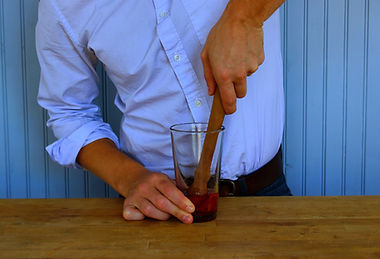Overview
Muddling is the simplest way to incorporate fresh ingredients into a cocktail. This is done, appropriately, with a muddler. The technique itself is pretty straightforward; it's basically the same as using a mortar and pestle. You crush ingredients and extract their flavors.
Keep in mind, most fresh ingredients going into a cocktail are fragile and don’t need to be pulverized which can dampen their flavors - particularly in the case of herbs. Typically, all you need are five to seven firm presses to get the results you need.
Other muddling factors to consider include the type of muddler you’re using - for a look at the available options visit the Muddler page - and how you hold it. As usual, these will probably be bigger concerns for professional bartenders.
Below is my personal approach to muddling. But like all cocktail techniques, as long as you accomplish the mission, you can approach it however you want.
Muddling








Press. Position the muddler over the fresh ingredient, press down slowly and firmly, keeping the handle end against the heel of your the palm. You're acting more like a hydraulic press rather than a jackhammer.
Add fresh ingredients to be muddled.
Add the sweetener.
Position. Place the end of the muddler at the base of your palm.
Grip. Wrap your hand around so you're holding the muddler somewhat like a sword. Then imagine you're about to do battle in an epic medieval version of the movie "Cocktail."
Alternative
"Potato Masher" Method
Here you're holding the muddler like you're mashing potatoes. It's a bit more work because you're solely relying on your wrist and forearm to apply pressure. But for just a few rounds at a time, that won't make much of a difference, especially if it's muddling herbs. If this way is more comfortable, go for it. Everything else is the same as above. Muddle in just the sweetener and press and twist 5-7 times.
Step 1: Muddle with only the Sweetener
If you combine all of a cocktail's ingredients before you muddle, you'll be bobbing with the muddler trying to pin down whatever you're trying to crush - which is less effective, and worse, it's annoying. That's why I advise muddling with just the sweetener, which will often be simple syrup and a small quantity, so your ingredient to be muddled will remain a nice stationary target on the bottom of your mixing vessel.
Another reason why sugar is a good candidate for muddling with is it's a great flavor conductor, particularly with herbs. Muddling them with nothing, or "dry", doesn't allow the extracted flavors to be fully absorbed. That being said, juicier ingredients like fruits and vegetables are fine to be muddled all by themselves. Their flavors will easily make their way into the drink once crushed up.
Step 2: Grip Muddler, Like a Sword
My preferred way to hold a muddler is with the handle up against the heel of the palm so I can apply pressure with my shoulder and upper arm, getting more leverage with less effort. Leaving the burden on just the wrist and forearm can get tiring, especially over a long shift.
Works best with Large Muddlers
Admittedly, this method is better suited for longer muddlers - 10 inches or so - with a wider handle end, like the one pictured below. They will keep your fingers from scraping up against the edge of the mixing vessel and fit more comfortably into your palm. I highly recommend these for bartenders, you can see some of the options here. Many common retail muddlers tend to be around 8 inches and narrower. They'll get the job done just fine, though if you're using one you may want to go with the alternative method shown below.
2.
1.
1.
2.
Twist. Twist from your wrist and apply pressure as needed. Herbs should be lightly bruised, but not ground up, which can release bitter tannins. Whole fruits and vegetables require a little more force to crush them, but they don't need to be mashed into a pulp.

1.
2.
Step 3: Press and Twist
Twisting the muddler helps to bruise and break things up a little more easily so you don’t have to exert as much force when applying pressure.
Don't Over-Muddle!
The goal is to crush and extract, not grind and pulverize. For herbs 5 to 7 strong presses and twists, aka "muddles", is usually enough. For fruits and veggies you may need a handful more, but not many. If you're unsure whether you've muddled enough, give the shaker a whiff. If there's a fragrant bouquet of whatever you’ve just muddled, you're all set. If the aromatics are faint, muddle a few more times. As always, use your best judgment.
1.
2.
Twist.
Press.

